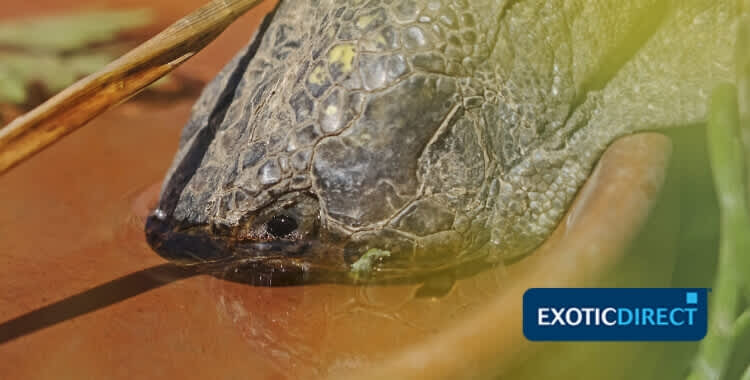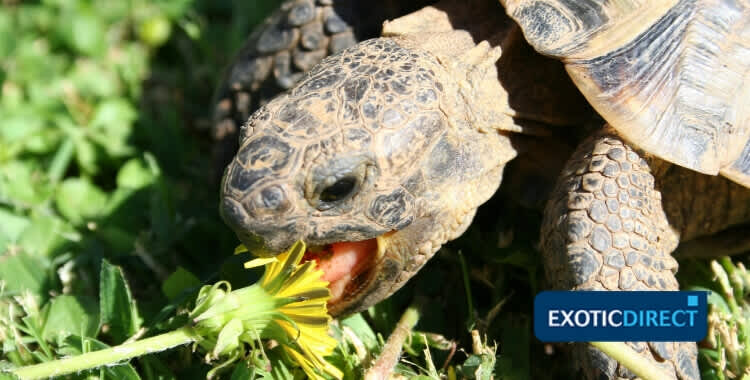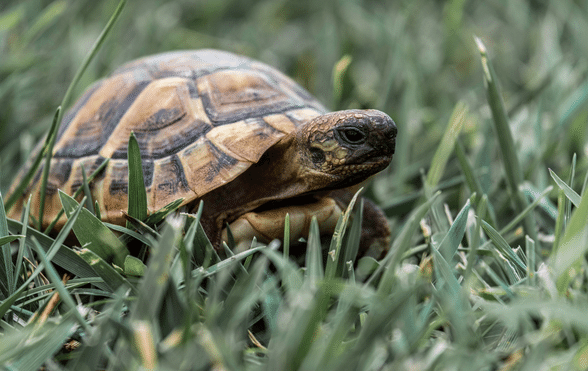Do you know how to care for your tortoise after its emerged from hibernation? What should you do, and when should you be concerned?…..
Is your tortoise insured? Get a quote for £2,500 of vet fees, death and theft cover. Vet fee cover only also available | We’ve been insuring exotic pets since 1996 | Check out our customer reviews on Feefo.
Find out more about:
To wake your tortoise up you should place your tortoise in a warm room for a few hours. And gradually it will start to wake up.
After emerging from hibernation, your tortoise will be dehydrated, so it is very important to provide your tortoise with a shallow bath each day at this stage.
Use a clean, empty plastic ice cream container or a bowl for this purpose, but keep it exclusively for the tortoise and always tip the contents down an outside drain for hygienic reasons, rather than the sink.
Tortoise bathing after hibernation
Start by filling the container with tepid water, up to the level of your tortoise’s mouth. You should add the water before you put your tortoise in.
This will allow it to dip its head under the water easily, without being totally submerged.
You can also add a vitamin solution to the water, following the instructions carefully as stated on the packaging. Be careful of overdosing, as this can be harmful, particularly over a period of time.
Leave your tortoise here for around 10 minutes or so, although you may find that your tortoise wants to clamber out beforehand, so always place the bowl on the floor.
This means here will be no risk of your pet tumbling down to the ground off a table for example, and being injured as a result.
Continue the baths for around a week or so, depending how your tortoise responds. Once a tortoise is fully awake and lively, make sure that it simply has a container of water available.
Choose a bowl which has a secure base and cannot be tipped over easily, in case your tortoise wants to continue bathing occasionally.
The sides of the water container should be relatively shallow, to give easy access – you can find bowls of this type at pet shops which specialise in reptiles. Also be sure to clean the bowl regularly using a reptile-safe disinfectant.

How to get a tortoise to eat after hibernation
Bathing and heating are two very important factors in encouraging your tortoise to eat, post hibernation.
Giving a daily bath to your tortoise will help its vision in the first few days after it wakes. At this stage, it is quite normal for the eyelids to be sticky, so a tortoise will otherwise have difficulty keeping its eyes open and will be unlikely to eat properly, because it cannot see its food.
Tortoises also need to be kept warm in order to maintain their appetite. Invest in a special full spectrum lamp which emits UVA light to encourage feeding, and a heater under thermostatic control.
You should also provide a basking spot of at least 26 degrees C (78 degrees F). These will ensure your tortoise is warm even when the weather is too cold or damp for it to go outdoors.
Your tortoise should have regained its appetite within about 10-14 days. If this isn’t the case your tortoise may have post hibernation anorexia.

Best food for tortoises after hibernation
Your tortoise will instinctively be seeking juicy foods which contain high levels of water as a way of helping to rehydrate itself, with tomatoes and small chunks of cucumber being valuable for this purpose.
Equally, it is important to provide foods with a higher level of fibre. Young dandelion leaves are now starting to emerge, and are popular choice of food with many tortoises. Do not offer cabbage if possible though, as this can have an adverse effect on your pet’s metabolism.
You can add a special broad spectrum vitamin and mineral powder, as sold specifically for reptiles, to the food on offer, so as to boost your tortoise’s immune system after a relatively long time without any nutrients.
One particular vitamin, known as B12 or cyanocobalamin, has been identified as an important appetite stimulant for tortoises, and this should help to encourage your pet’s appetite.
There are also special formulated pellets which are available for tortoises from specialist reptile outlets. These are rather like a complete dry dog or cat food, and contain a full spectrum of the vitamins and minerals which tortoises are likely to require.
If your pet eats pellets it is normally not necessary to use a supplement as well.
Cover your tortoise for £2,500 of vet fees, death and theft. Vet fee cover only also available.
Should I add water to tortoise pellets?
Yes, you can soak the pellets in a little water in the tortoise’s feeding dish to make them moist at first, but take care not to flood them otherwise they are likely to break down into an uneaten soggy mess.
Only leave moistened pellets in your pet’s quarters for up to half a day, because once wet, they can then turn mouldy quite quickly in warm surroundings. This can endanger your tortoises health.
Weighing tortoises after hibernation
Weigh your tortoise as soon as it wakes, and then you can keep a diary, plotting how its weight changes until the autumn.
This is because tortoises will build up their store of body fat again during the early summer, in preparation for next winter.
Should your tortoise lose valuable time not eating properly now, then it may fail to reach a sufficiently healthy state to hibernate later in the year, even if it eats very well from the late summer through until the autumn.
You’ll be able to use your weight records each year as a weight gaining guide.
When planning hibernation, don’t forget to use a suitable chart as discussed here.
Post hibernation anorexia in tortoises
If your tortoise fails to regain its appetite within two weeks of emerging from hibernation however, do not delay in seeking veterinary advice.
Try to find a vet who is used to seeing reptilian patients. A common underlying cause of anorexia in tortoises is a mouth infection which will need to be treated, before your pet will begin to eat properly again.
Supplementary feeding, by means of a stomach tube, can often be very valuable during this period, helping your pet to build up its strength again, and this can be undertaken while your tortoise is being treated by the vet.
If you have a tortoise insurance policy that covers vet fees with ExoticDirect, then you will be able to provide the best possible vet care. This means you won’t have to worry about the cost of it all while your tortoise is ill. Naturally any claims are subject to Policy Terms and Conditions, which you’ll be able to find in your ExoticDirect policy book.
David Alderton is an award-winning author and broadcaster, specialising in the field of pets and the care, whose books have sold some 7 million copies in 31 languages.
He grew up in a household with pets of all types and trained as a veterinary surgeon at Cambridge University, until an allergy to soaps and scrubs in his final year forced a change of career and led him into writing about animals instead.
Is your tortoise insured? Get a quote for £2,500 of vet fees, death and theft cover. Vet fee cover only also available | We’ve been insuring exotic pets since 1996 | Check out our customer reviews on Feefo.

